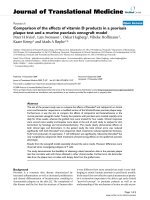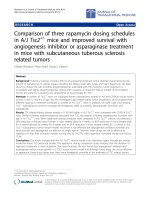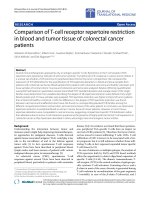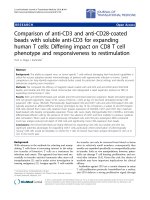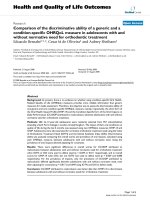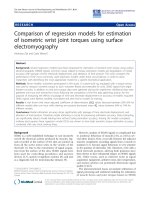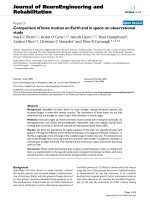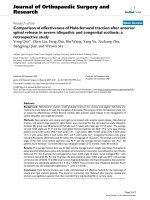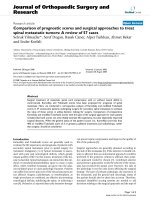Báo cáo hóa học: " Comparison of regression models for estimation of isometric wrist joint torques using surface electromyography" potx
Bạn đang xem bản rút gọn của tài liệu. Xem và tải ngay bản đầy đủ của tài liệu tại đây (1.87 MB, 12 trang )
RESEARCH Open Access
Comparison of regression models for estimation
of isometric wrist joint torques using surface
electromyography
Amirreza Ziai and Carlo Menon
*
Abstract
Background: Several regression models have been proposed for estimation of isometric joint torque using surface
electromyography (SEMG) signals. Common issues related to torque estimation models are degradation of model
accuracy with passage of time, electrode displacement, and alteration of limb posture. This work compa res the
performance of the most commonly used regression models under these circumstances, in order to assist
researchers with identifying the most appropriate model for a specific biomedical application.
Methods: Eleven healthy volunteers participated in this study. A custom-built rig, equipped with a torque sensor,
was used to measure isometric torque as each volunteer flexed and extended his wrist. SEMG signals from eight
forearm muscles, in addition to wrist joint torque data were gathered during the experiment. Additional data were
gathered one hour and twenty-four hours following the completion of the first data gathering session, for the
purpose of evaluating the effects of passage of time and electrode displacement on accuracy of models. Acquired
SEMG signals were filtered, rectified, normalized and then fed to models for training.
Results: It was shown that mean adjusted coefficient of determination
(R
2
a
)
values decrease between 20%-35% for
different models after one hour while altering arm posture decreased mean
R
2
a
values between 64% to 74% for
different models.
Conclusions: Model estimation accuracy drops significantly with passage of time, electrode displacement, and
alteration of limb posture. Therefore model retraining is crucial for preserving estimation accuracy. Data resampling
can significantly reduce model training time without losing estimation accuracy. Among the models compared,
ordinary least squares linear regression model (OLS) was shown to have high isometric torque estimation accuracy
combined with very short training times.
Background
SEMG is a well-established technique to non-invasively
record the electrical a ctivity produced by muscles. Sig-
nals recorded at the surface of the skin are picked up
from all the active motor units in the vicinity of the
electrode [1]. Due to the convenience of signal acquisi-
tion from the surface of the skin, SEMG signals have
been used for controlling prosthetics and assistive
devices [2-7], speech recognition systems [8], and also
as a diagnostic tool for neuromuscular diseases [9].
However, analysis of SEMG signals is complicated due
to nonlinear behaviour of muscles [10], as well as sev-
eral other factors. First, cross talk between the adjacent
muscles complicates recording signals from a muscle in
isolation [11]. Second, signal behaviour is very sensitive
to the position of electrodes [12]. Moreover, even with a
fixed electrode position, altering limb positions have
been shown to have substantial impact on SEMG signals
[13]. Other issues, such as inherent noise in signal
acquisitio n equipment, ambient noise, skin temperature,
and motion artefact can potentially deteriorate signal
quality [14,15].
The aforementioned issues necessitate utilization of
signal proce ssing and stati stical modeling for estimation
of muscle forces and joint torques based on SEMG
* Correspondence:
MENRVA Research Group, School of Engineering Science, Faculty of Applied
Science, Simon Fraser University, 8888 University Drive, Burnaby, BC, V5A 1S6,
Canada
Ziai and Menon Journal of NeuroEngineering and Rehabilitation 2011, 8:56
/>JNER
JOURNAL OF NEUROENGINEERING
AND REHABILITATION
© 2011 Ziai and Menon; licensee BioMed Central Ltd. This is an Open Access article distributed under the terms of the Creative
Commons Attribution License ( which permits unrest ricted use, distribution, and
reproduction in any medium, provided the original work is properly cited.
signals. Classification [16] a nd regression techniques
[17,18], as well as physiological models [19,20], have
been considered by the research community extensiv ely.
Machine learning classification methods i n aggregate
have proven to be viable methods for classifying limb
postures [21] and joint torque levels [22]. Park et al.
[23] compared the performance of a Hill-based muscle
model, linear regression and artificial neural networks
forestimationofthumb-tipforcesunderfourdifferent
configurations. In another study, performance of a Hill-
based physiological muscle model was compared to a
neural network for estimation of forearm flexion and
extension joint torques [24]. Both groups showed that
neural network predictions are superior to Hill-based
predictions, but neural network predictions are task spe-
cific and require ample training before usage. Castellini
et al. [22] and Yang et al. [25], in two distinct studies,
estimated grasping forces using artificial neural networks
(ANN), support vectors machines (SVM) and locally
weighted projection regressi on (LWPR). Yang concluded
that SVM outperforms ANN and LWPR.
This study was intended to compare performance of
commonly utilized regression models for isometric tor-
que estimation and identify their merits and shortcom-
ings under circumstances where the accuracy of
predictive models has been reported to be compromised.
Wrist joint was chosen as its functionality is frequently
impaired due to aging [26] or stro ke [7], and robots
(controlled by SEMG signals) are developed to train and
assist affected patients [2,3]. Performance of five differ-
ent models for estimation of isometric wrist flexion and
extension torques are compared: a physiological based
model (PBM), an ordinary least squares linear regression
model (OLS), a regularize d least squares linear regres-
sion model (RLS), and three machine learning techni-
ques, namely SVM, ANN, and LWPR.
Physiological Based Model
Physiological based model (PBM) used i n this study is a
neuromusculoskeletal model used for estimation of joint
torques from S EMG signals. Rectified and smoothed
SEMG signals have been reported to result in poor esti-
mations of m uscle forces [27,28]. This is mainly due to
(a) existence of a delay between SEMG and muscle ten-
sion onset (electromechanical delay) and (b) the fact that
SEMG signals have a shorter duration than resulting
forces. It has been shown t hat muscle twitch response
can be modeled well by using a critically damped linear
second order differential equation [29]. However since
SEMG signals are generally acquired at discrete time
intervals, it is appropriate to use a discretized form.
Using backward differences, the differential equation
takes the form of a discrete recursive filter [30]:
u
j
(t) =
αe
j
(t − d) − β
1
u
j
(t − 1) − β
2
u
j
(t − 2)
(1)
where e
j
is the processed SEMG signal of muscle j at
time t, d is the electromechanical delay, a is the gain
coefficient, u
j
(t) is the post-processed SEMG signal at
time t, and b
1
and b
2
the recursive coefficients for mus-
cle j.
Electromechanical delay was allowed to vary between
10 and 100 ms as that is the range for skeletal muscles
[31]. The recursive filter maps SEMG values e
j
(t) for
muscle j into post-processed values u
j
(t). Stability of this
equation is ensured by satisfying the following con-
straints [32]:
β
1
=C
1
+C
2
β
2
=C
1
× C
2
|C
1
| < 1
|C
2
| < 1
(2)
Unstable filters will cause u
j
(t) values to oscillate or
even go to inf inity. To ensure stability of this filter and
restrict the maximum neural activation values to one,
another constraint is imposed:
α − β
1
− β
2
=1
(3)
Neural activation v alues are conventionally restricted
to values between zero a nd one, where zero implies no
activation and one trans lates to full voluntary activation
of the muscle.
Although isometric forces produced b y certain mus-
cles exhibit linear relationship with activation, nonlinear
relationships are observed for other muscles. Nonlinear
relationship s are m ostly witnessed for forces of up to
30% of the maximum isometric force [33]. These non-
linear relationships can be associated with exponential
increases in firing rate of motor units as muscle forces
increase [34]:
a
j
(t) =
e
Au
j
(t)
− 1
e
A
− 1
(4)
where A is called the non-linear shape factor. A = -3
corresponds to highly exponential behaviour of the mus-
cle and A = 0 corresponds to a linear one.
Once nonlinearities are explicitly taken into account,
isometric forces generated by each muscle at neutral
joint position at time t are computed using [35]:
F
j
(t) = F
max,j
× a
j
(t)
(5)
where F
max,j
is the maximum voluntary force produced
by muscle j.
Ziai and Menon Journal of NeuroEngineering and Rehabilitation 2011, 8:56
/>Page 2 of 12
Isometric joint torque is computed by multiplying iso-
metric force of each muscle by its moment arm:
τ
j
(t) = F
j
(t) × MA
j
(6)
where MA
j
is moment arm at neutral wrist position
for muscle j and τ
j
(t) is the torque generated by muscle
j at time t. Moment arms for flexors and extensors were
assigned positive and negative signs respectively to
maintain consistency with measured values.
As not all forearm muscles were accessible by surface
electrodes, each SEMG channel was assumed to repre-
sent intermediate and d eep muscles in its proximity in
addition to the surface muscle it was recording from.
Torque values from each channel were then scaled
using mean physiological cross-section area (PCSA)
valuestabulatedbyJacobsonetal.andLieberetal.
[36-38]. Joint torque estimation values have been shown
not to be highly sensitive to muscle PCSA values and
therefore these values were fixed and not a part of
model calibration [39]. The isometric torque at the wrist
joint was computed by adding individual scaled torque
values:
τ
e
(t) =
M
j=1
PCSA
j
PCSA
j
× τ
j
(t)
(7)
where M is the number of muscles used in the model,
and ΣPCSA
j
is the summation of PCSA of the muscle
represents by muscle j and PCSA of muscle j itself.
EDC, ECU, ECRB, PL, and FDS rep resented extensor
digiti minimi (EDM), extensor indicis proprius (EIP),
extensor pollicis longus (EPL), flexor pollicis longus
(FPL), and flexor digitorum profundus (FDP) respec-
tively due to their anatomical proximity [40]. Abductor
pollicis longus (APL) and extensor pollicis brevis (EPB)
contribute negligibly to wrist torque generation due to
their small moment arms and were not considered in
the model [41]. Steps and parameters involved in t he
PBM are summarized in Figure 1.
Models were calibrated to each volunteer by tuning
model parameters. Yamaguchi [42] has summarized
maximum isometric forces reported by different investi-
gators. We used means as initial values and constrained
F
max
to one standard deviation of the reported values.
Initial values for moment arms were fixed to the mean
values in [43], and constrained to one standard deviation
of th e values reported in the same reference. Since these
parameters are constrained within their physiologically
acceptable values, calibrated models can potentially pro-
vide physiological insi ght [24]. Activation parameters A,
C
1
,C
2
, and d were assumed to be constant for all mus-
cles a model with too many parame ters loses its predic-
tive power due to overfitting [44]. Parameters x = {A,
C
1
,C
2
,d,F
max,1
, ,F
max,M
,MA
1
,MA
2
, ,MA
M
}were
tuned by optimizing the following objective function
while constraining parameters to values mentioned
beforehand:
min
X
(τ
e
(t) − τ
m
(t))
2
(8)
Models were optimized by Genetic Algorithms (GA)
using MATLAB Global Optimization Toolbox (details
of GA implementation are available in [45]). GA has
previously been used for tunin g muscle models [20].
Default MATLAB GA parameters were used and models
were tuned in less than 100 generations (MATLAB
default value for the number of optimization iterations)
[46].
Ordinary Least Squares Linear Regression Model
torques using processed SEMG signals [23]. Linear
regression is presented as:
[τ
m
]
N×1
=[SEMG]
N×M
[β]
M×1
+[ε]
N×1
(9)
where N is the number of samples conside red (obser-
vations), M is the number of muscles, τ
m
is a vector of
measured torque values, SEMG is a matrix of processed
SEMG signals, b is a vector of regression coefficients to
be estimated, and ε is a vector of independent random
variables.
Ordinary least squares (OLS) method is most widely
used for estimation of regression coefficients [ 47]. Esti-
mated vector of regression coefficients using least
squares method
(
ˆ
β)
is computed using:
ˆ
β =
[SEMG]
T
[SEMG]
−1
[SEMG]
T
[τ
m
]
(10)
Once the model is fitted, SEMG values can be used
for estimation of torque values (τ
e
) as shown:
[τ
e
]
N×1
=[SEMG]
N×M
ˆ
β
M×1
(11)
Regularized Least Squares Linear Regression Model
The ℓ
1
-regularized least squares (RLS) method f or esti-
mation of regression coefficients is known to overcom e
some of the common issues associated with the ordinary
least squares method [48]. Estimated vector of
Figure 1 Steps and parameters involved in the PBM.
Ziai and Menon Journal of NeuroEngineering and Rehabilitation 2011, 8:56
/>Page 3 of 12
regression coefficients using ℓ
1
-regularized least squares
method
(
ˆ
β)
is computed through the following optimi-
zation:
minimize
M
i=1
λ|
ˆ
β
i
|
+
N
i=1
[SEMG]
N×M
[
ˆ
β]
M×1
+[ε]
N×1
− [τ
m
]
N×1
2
(12)
where l ≥ 0 is the regularization parameter which is
usually set equal to 0.01 [49,50].
We used the Matlab implementation of the ℓ
1
-regular-
ized least squares method [51].
Support Vector Machines
Support vectors machines (SVM) are machine learning
methods used for classification and regression. Support
vector regression (SVR) maps input data using a non-
linear mapping to a higher-dimensional feature space
where linear regression can be applied. Unlike neural
networks, SVR does not suffer from the local minima
problem since model parameter estimation involves sol-
ving a convex optimization problem [52].
We used epsilon support vector regression (ε-SVR)
available in the LibSVM tool for Matlab [53]. Details of
ε-SVR problem formulation are available in [54]. ε-SVR
has previously been utilized for estimation of grasp
forces [22,25]. The Gaussian kernel was used as it
enables nonlinear mapping of samples and has a low
number of hyperparameters, which reduces complexity
of model selection [55]. Eight-fold cross-validation to
generalize error values and grid-search for finding the
optimal values o f hyperparameters C, g and ε were car-
ried out for each model.
Artificial Neural Networks
Artificial neural networks (ANN) have been used for
SEMG classification and regression extensively
[22,25,56,57]. Three layer neural networks have been
shown to be adequate for modeling problems of any
degree of complexity [58]. We used feed-forward back
propagation network with one input layer, two hidden
layers, and one output layer [59]. We also used BFGS
quasi-Newton training that is much faster and more
robust than simple gradient descent [60]. Network
structure is depicted in Figure 2, where M is the num-
ber of processed SEMG channels used as inputs to the
ANN and τ
e
is the estimated torque value.
ANN models were trained using Matlab Neural Net-
work Toolbox. Hyperbolic tangent sigmoid activation
functions were used to capture the nonlinearities of
SEMG signals. For each model, the training phase was
repeated ten times and the best model was picked out
of those repetitions in order to overcome the local
minima problem [52]. We also used early stopping and
regularization in order to improve generalization and
reduce the likelihood of overfitting [61].
Locally Weighted Projection Regression
Locally Weighted Projection Regression (LWPR) is a
nonlinear regression method for high-dimensional
spaces with redundant and irrelevant input dimensions
[62]. LWPR employs nonparametric regression with
locally linear models based on the assumption that high
dimensional data sets have locally low dimensional dis-
tributions. However piecewise linear modeling utilized
in this method is computationally expensive with high
dimensional data.
We used Radial Basis Function (RBF) kernel and
meta-learning and then performed an eight-fold cross
validation to avoid overfitting. Finally we used grid
search to find the initial values of the distance metric
for receptive fields, as it is customary in the literature
[22,25]. Models were trained using a Matlab version o f
LWPR [63].
Methods
A custom-built rig was designed to allow for measure-
men t of isometric torques exerted about the wrist joint.
Volunteers placed their palm on a plate and Velcro
straps were used to secure their hand and forearm to
the plate. The plate hinged about the axis of rotation
shown in Figure 3.
A Transducer Techniques TRX-100 torque sensor,
with an axis of rotation corresponding to that of the
volunteer’ s wrist joint, was used to measure torques
applied about the wrist axis of rotation. Volunteer’ s
forearm was secured to the rig using two Velcro straps.
This design allowed restric tion of arm movements.
Volunteer placed their elbow on the rig and assumed an
upright position.
SEMG
SEMG
M
output
node
hidden
nodes
input
nodes
τ
e
Figure 2 ANN structure.
Ziai and Menon Journal of NeuroEngineering and Rehabilitation 2011, 8:56
/>Page 4 of 12
Protocol
Eleven healthy volunteers (eight males, three females,
age 25 ± 4, mass 74 ± 12 kg, height 176 ± 7 cm), who
signed an informed consent form (project approved by
the Office of Research Ethics, Simon Fraser University;
Reference # 2009 s0304), participated in this study . Each
volunteer was asked to flex and then extend her/his
right wrist with maximum voluntary contraction (MVC).
Once the MVC values for both flexion and extension
were determined, the volunteer was asked t o gradually
flex her/his wrist to 50% of MVC. Once the 50% was
reached the volunteer gradually decreased the exerted
torque to zero. This procedure was repeated three times
for flexion and then for extension. Finally the volunteer
was asked to flex and extend her/his wrist to 25% of
MVC three times. Figure 4 shows a sample of torque
signals gathered. Positive values on the scale are for flex-
ion and negative values are for extension.
Following the completion of this protocol, volunteers
were asked to supinate their forearm, and follow the
same protocol as before. Figure 5 shows forea rm in pro-
nated and supinated positions.
Completion of protocols in both pronated and supi-
nated forearm positions was called a session. Table 1
summarizes actions in protocols.
In order to capture the effects of passage of time on
model accuracy, volunteers were asked to repeat the
same session after one hour. This session was named
session two. E lectrodes were not detached in betw een
the two sessions. After completion of session two, elec-
trodes were removed from the volunteer’ sskin.The
volunteer was asked to r epeat another session in twenty
four hours following session two while attaching new
electrodes. This was intended to capture the effects of
electrode displacement and further time passage.
Each volunteer was asked to supinate her/his forearm
and exert isometric torques on the rig following the
same protocol used before after completion of session 1.
This was intended to study the effects of arm posture
on model accuracy.
SEMG Acquisition
A commercial SEMG acquisition system (Noraxon Myo-
system 1400L) was used to acquire signals from eight
SEMG channels. Each channel was connected to a
Figure 3 Custom-built rig equipped with a torque sensor.
Figure 4 Sample torque signal.
Figure 5 Volunteer’s forearm on the testing rig.(a)Forearm
pronated. (b) Forearm supinated.
Table 1 Actions and repetitions for protocols.
Repetition Action
1 Wrist flexion with maximum torque
1 Wrist extension with maximum torque
3 Gradual wrist flexion until 50% MVC and gradual decrease
to zero
3 Gradual wrist extension until 50% MVC and gradual
decrease to zero
3 Gradual wrist flexion until 25% MVC and gradual decrease
to zero
3 Gradual wrist extension until 25% MVC and gradual
decrease to zero
Ziai and Menon Journal of NeuroEngineering and Rehabilitation 2011, 8:56
/>Page 5 of 12
Noraxon AgCl gel dual electrode that picked up signals
from the muscles tabulated in Table 2.
It has been reported that the extrinsic muscles of the
forearm have large torque generating contributions in
isometr ic flexion and extension [64]. Therefor e we con-
sidered three superf icial secondary forearm muscles as
well as the primary forearm muscles accessible via
SEMG. The skin preparation procedure outlined in sur-
face electromyography for the non-invasive assessment
of muscles project (SENIAM) was followed to maximize
SEMG signal quality [65]. Figure 6 shows the position of
electrodes attached to a volunteer’s forearm.
SEMG signals were acquired at 1 kHz using a
National Instruments (NI-USB-6289) data acquisition
card. An application was developed using LabVIEW
software that stored data on a computer and provided
visual feedback for volunteers. Visual feedback consisted
of a bar chart that visualized the magnitude of exerted
torques, which aided volunteers to fo llow the protocol
more accurately.
Signal Processing
Initially DC offset values of SEMG signals were
removed. Signals were subsequently high-pass filtered
using a zero-lag Butterworthfourthorderfilter(30Hz
cut-off frequency), in order to remove motion artefact.
Signals were then low-pass filtered using a zero-lag But-
terworth fourth order f ilter (6 Hz cut-off fr equency),
full-wave rectified and normalized to the maximum
SEMG value for each channel. Figure 7 shows the signal
processing scheme.
33,520 samples were acquired from each of the eight
SEMG channels and the torque sensor for each volun-
teer. The data set was broken down into training and
testing data. Figure 8 shows a sample of raw and pro-
cessed SEMG signals.
Results and Discussion
Models were initially trained with the training data set.
The performance of trained models was subsequently
tested by comparing estimated to rque values from the
model and the actual torque values from the testing
data set. Two accuracy metrics were used to compare
the performance of different models: normalized ro ot
mean squared error (NRMSE) and adjusted c oefficient
of determination
(R
2
a
)
[64]. Root mean squared error
(RMSE) is a m easure of t he difference between mea-
sured and estimated values. NRMSE is a dimensionless
metric expressed as RMSE over the range of measured
torques values for each volunteer:
NRMSE =
n
i=1
(τ
e
(i)−τ
m
(i))
2
n
τ
m,flex
+ |τ
m,ext
|
(13)
where τ
e
(i) i s the estimated and τ
m
(i) i s the measured
torque value for sample i, n corresponds to the total
number of samples tested, and τ
m,flex
and τ
m,ext
are the
maximum flexion and extension torques exerted by each
volunteer. The absolute value of τ
m,ext
is considered
because of the negative sign assigned to extension tor-
que values during signal acquisition.
R
2
is a measure of the percentage of variation in the
dependant variable (torque) collectively explained by the
independent variables (SEMG signals):
Table 2 Muscles monitored using SEMG.
Channel Muscle Action
1 Extensor Carpi Radialis Longus (ECRL) Wrist extension
Radial deviation
2 Extensor Digitorum Communis (EDC) Wrist extension
Four fingers extension
3 Extensor Carpi Ulnaris (ECU) Wrist extension
Ulnar deviation
4 Extensor Carpi Radialis Brevis (ECRB) Wrist extension
Wrist abductor
5 Flexor Carpi Radialis (FCR) Wrist flexion
Radial deviation
6 Palmaris Longus (PL) Wrist flexion
7 Flexor Digitorum Superficialis (FDS) Wrist flexion
8 Flexor Carpi Ulnaris (FCU) Wrist flexion
Ulnar deviation
Figure 6 Electrode positions. Figure 7 SEMG signal processing scheme.
Ziai and Menon Journal of NeuroEngineering and Rehabilitation 2011, 8:56
/>Page 6 of 12
(14)
where
τ
m
is the mean measured torque.
However R
2
has a t endency to overestimate the
regression as more independent variables are a dded to
the model. For this reason, many researchers recom-
mend adjusting R
2
for the number of independent vari-
ables:
R
2
a
=1−
n − 1
n − k − 1
× (1 − R
2
)
(15)
where
R
2
a
is the adjusted R
2
,nisthenumberofsam-
ples and k is the number of SEMG channels.
Models were trained u sing every 100 data resampled
from the processed signals to save model training time.
Data set was reduced to 335 samples with resampling.
Training time t, was measured as the number of seconds
it took for each model to be trained. All training and
testing was performed on a computer with an Intel
®
Core™2Duo2.5GHzprocessorand6GBofRAM.
Table 3 compares mean training times for models
trained using the original and resampled data sets.
One-way Analysis of Variance (ANOVA) failed to
reject the null hypothesis that NRMSE and
R
2
a
have dif-
ferent mean values for each model, meaning that the
difference between means is not significant (with mini-
mum P-value of 0.95). We used reduced data sets with
data resampled every 100 samples for the rest of the
study.
Number of Muscles
As merely one degree o f freedom of the wrist was con-
sidered in this study, the possibility of training models
using only two primary muscles was investigated initi-
ally. There are six combinations possible with one pri-
mary flexor and one primary extensor muscle: FCR-
ECRL, FCR-ECRB, FCR-ECU, FCU-ECRL, FCU-ECRB,
and FCU-ECU. Models were trained using 75% of the
data for all six combinations and then tested on the
remaining 25% and the model with the best perfor-
mance was picked. Mean and standard deviation of
NRMSE and
R
2
a
for models trained with two, five, and
eight channels are presented in Table 4.
It is noteworthy that best performance was not consis-
tently attributed to a single combination of muscles for
the case of models trained with two channels. It is evi-
dent that models trained with five channels are superior
to models trained with two. However models trained
with eight channels do not have significant performance
superiority. Figure 9 compares NRMSE and
R
2
a
for dif-
ferent number of training channels.
This result appears to be in contrast to the results
obtained by Delp et al. [66] where extrinsic muscles of
the hand are expected to contribute substantially to tor-
que generation. However, due to the design of our test-
ing rig, volunteers only generated torque by pushing
Figure 8 Sample SEMG signal. (a) Raw. (b) Filtered.
Table 3 Model training times for original and resampled
data sets.
Time (s) PBM OLS RLS SVM ANN LWPR
Original 1,080.07 0.01 1.98 19,125.31 166.73 5,195.03
Resampled 10.96 0.00 0.03 15.32 9.40 18.63
Table 4 Comparison of joint torque estimation for
models trained with two, five, and eight SEMG channels.
Model 8 channels 5 channels 2 channels
NRMSE
R
2
a
NRMSE
R
2
a
NRMSE
R
2
a
PBM Mean 2.73% 0.85 3.07% 0.86 4.59% 0.77
STD 0.97% 0.13 1.03% 0.11 1.32% 0.19
OLS Mean 2.88% 0.84 3.17% 0.77 4.82% 0.63
STD 0.94% 0.11 1.06% 0.13 1.81% 0.23
RLS Mean 2.83% 0.82 3.11% 0.79 4.73% 0.69
STD 0.93% 0.10 1.01 0.11 1.31% 0.18
SVM Mean 2.85% 0.82 3.00% 0.80 4.77% 0.73
STD 1.00% 0.09 1.04% 0.10 1.02% 0.14
ANN Mean 2.82% 0.82 3.03% 0.81 4.74% 0.69
STD 0.95% 0.09 1.05% 0.12 1.17% 0.18
LWPR Mean 3.03% 0.75 3.19% 0.78 4.97% 0.69
STD 1.14% 0.21 1.19% 0.13 1.31% 0.21
Ziai and Menon Journal of NeuroEngineering and Rehabilitation 2011, 8:56
/>Page 7 of 12
their palms against the torque-sensing plate and their
fingers did not contribute to torque generation. There-
fore the addition of SEMG signals of extrinsic muscles
to the model did not result in a significant increase in
accuracy.
It should be noted t hat using mo re data for training
models increases accuracy for same session models.
Table 5 compares NRMSE and
R
2
a
for two extreme
cases where 25% and 90% of the data set is used for
training models and t he rest of the data set is used for
testing using all SEMG channels.
Mean
R
2
a
values increased 19%, 21%, 18%, 14%, 32%,
and 26% while mean NRMSE values decreased 47%,
48%, 50%, 54%, 60%, and 46% for PBM, OLS, RLS,
SVM, ANN, and LWPR, respectively. Figure 10 visua-
lizes NRMSE and
R
2
a
for the two cases.
For PBM training with two and five channels, ΣPCSA
term in equation 7 was modified. For the two channel
case, equation 7 took the following form:
τ
e
(t) =
PCSA
f1exors
PCSA
f1exor
× τ
flexor
(t)
+
PCSA
extensors
PCSA
extensor
× τ
extensor
(t)
(16)
where ΣPCSA
flexors
is the summation of PCSA of all
flexor muscles, ΣPCSA
extensors
is the summation of
PCSA of all extensor muscles, PCSA
flexor
is the PCSA of
the flexor muscle u sed for training, PCSA
extensor
is the
PCSA of the extensor muscle used for training, τ
flexor
(t)
is the torque of the flexor muscle used for training at
time t , and τ
extensor
(t) is the torque of the flexor muscle
used for training at time t.
Similarly PBM training with the five primary wrist
muscles was carried out with modified ΣPCSA terms.
Figure 9 Effects of the number of SEMG channels used for
training on joint torque estimation. (a) NRMSE. (b)
R
2
a
.
Table 5 Comparison of training data set size on joint
torque estimation.
Model 25% training 90% training
NRMSE
R
2
a
NRMSE
R
2
a
PBM Mean 4.41% 0.81 2.32% 0.96
STD 2.49% 0.09 0.59% 0.04
OLS Mean 4.19% 0.80 2.19% 0.97
STD 2.19% 0.10 0.58% 0.04
RLS Mean 4.14% 0.82 2.07% 0.97
STD 2.13% 0.08 0.51% 0.03
SVM Mean 4.39% 0.85 2.02% 0.97
STD 2.46% 0.09 0.92% 0.03
ANN Mean 5.87% 0.73 2.34% 0.96
STD 2.20% 0.20 0.61% 0.03
LWPR Mean 6.41% 0.69 3.43% 0.87
STD 3.14% 0.29 0.84% 0.07
Figure 10 Effects of training data size on joint torque
estimation. (a) NRMSE. (b)
R
2
a
.
Ziai and Menon Journal of NeuroEngineering and Rehabilitation 2011, 8:56
/>Page 8 of 12
Half of the summation of PCSA values for non-primary
flexors was added to each of the two primary flexors
while a third of the summation of PCSA values for non-
primary extensors was added to the ΣPCS A term of
each of the three primary extensors.
These modifications allowed tuned parameters to stay
within their physiologically acceptable values, even
though less SEMG channels were used for training
models.
Cross Session
Passages of time as well as electrode displacement
adversely affect accuracy of models trained with SEMG
[22,25]. Models trained with session 1 were tested with
data from session 2 (in 1 hour without detaching elec-
trodes) and session 3 (in 24 hours and with new electro-
des attached ). Table 6 compares model performance for
the two cases.
Results suggest that model reliability deteriorates with
passag e of ti me. Figure 11 compares mean and standard
deviation of NRMSE and
R
2
a
of models trained with ses-
sion 1 and tested with data from the same session, after
1 and 24 hours.
Mean
R
2
a
values after one hour decreased 34%, 28%,
25%, 34%, 35%, and 20% while mean NRMSE decreased
93%, 68%, 70%, 88%, 91%, and 79% for PBM, OLS, RLS,
SVM, ANN, and LWPR, respectively. After twenty four
hours mean NRMSE values decreased further. High
standard deviations of NRMSE and
R
2
a
values suggest
unreliability of model predictions with passage of time
and electrode displacement. Therefore it is crucial for
models trained using SEMG signals to be retrained fre-
quently regardless of the model utilized.
Arm Posture
Arm posture changes SEMG signal characteristics [8].
A model trained with the forearm in pronated position
was utilized to predict the measured values from the
supinated position in the same session. Supinating the
forearm resulted in the torque sensor readings for
extension and flexion to be reversed. This was expli-
citly taken into account when processing signals. Pre-
diction accuracy of the trained models reduced
significantly with forearm supination as shown in
Table 7.
ANOVA shows that the hypothesis that NRMSE and
R
2
a
of testing was the same is refuted with P < 0.01.
Results from this experiment validat e that trained mod-
els are very sensitive to arm posture. Forearm supination
shifts SEMG signal space. Since models trained in the
pronated position do not take this shift into considera-
tion, accuracy decreases [22]. SEMG patterns chang e
with different arm postures that models need to expli-
citly take into consideration [67,68]. Figure 12 shows
the effects of forearm supination on prediction accuracy
of models trained with forearm in pronated position.
Mean NRMSE values increased 2.50, 2.10, 2.13, 2.04,
2.24, and 2.32 times for PBM, OLS, RLS, SVM, A NN,
and LWPR.
Table 6 Effects of passage of time and electrode
displacement on joint torque estimation.
Model After 1 hour After 24 hours
NRMSE
R
2
a
NRMSE
R
2
a
PBM Mean 5.28% 0.56 5.54% 0.47
STD 2.68% 0.24 2.95% 0.26
OLS Mean 4.84% 0.59 5.29% 0.51
STD 2.98% 0.27 3.04% 0.25
RLS Mean 4.81% 0.63 5.19% 0.54
STD 2.91% 0.23 2.98% 0.27
SVM Mean 5.35% 0.54 6.76% 0.46
STD 2.22% 0.21 2.95% 0.28
ANN Mean 5.40% 0.53 6.44% 0.51
STD 2.15% 0.28 3.09% 0.31
LWPR Mean 5.42% 0.60 5.93% 0.59
STD 3.00% 0.23 3.18% 0.30
Figure 11 Effects of passage of time and electrode
displacement on joint torque estimation. (a) NRMSE. (b)
R
2
a
.
Ziai and Menon Journal of NeuroEngineering and Rehabilitation 2011, 8:56
/>Page 9 of 12
Table 8 summarizes performance of models based on
different criteria. One advantage of machine learning
techniques is that these models can b e trained with raw
SEMG signals as they are capable of mapping the nonli-
nearities associated with raw SEMG signals. In contras t,
PBM c an only be trained with processed SEMG signals
since inputs to the PBM represent neural activity of
muscles (a value bounded between zero and one) [69].
Moreover, nonlinear behaviour of muscles [10] observed
in raw SEMG signals precludes utilization of linear
regression for mapping.
Conclusions
Eleven volunteers participated in this study. During the
first session, 33,520 samples from eight SEMG channels
and a torque sensor were acquired while volunteers fol-
lowed a protocol consisting of isom etric flexion and
extension of the wrist. We then processed SEMG signals
and resampled every 100 samples to save model trai ning
time. Subsequently we trained models using identical
training data sets. When using 90% of data as training
data set and the rest of the data as testing data, we
attained
R
2
a
values of 0.96 ± 0.04, 0.97 ± 0 .04, 0.97 ±
0.03, 0.97 ± 0.03, 0.96 ± 3, and 0.87 ± 0.07 for PBM,
OLS, RLS, SVM, ANN, and LWPR respectively. All
models p erformed in a very co mparable fashion, except
for LWPR that y ielded lower
R
2
a
values and higher
NRMSE values.
Models trained using the data set from session one
were tested using two separate data sets gathered one
hour and twenty four hours following session one. We
showed that Mean
R
2
a
values after one hour decrease
34%, 28%, 25%, 34%, 35%, and 20% for PBM, OLS, RLS,
SVM, ANN, and LWPR, respectively. Tests after twenty
four hou rs showed even further performance deteriora-
tion. Therefore it was concluded that all models consid-
ered in this study are sensitive to passage of time and
electrode displacement.
The effects of the number of SEMG channels used for
training were explored. Models trained with SEMG
channels from the five primary forearm muscles were
shown to be of similar predictive ability compared to
models trained with all eight SEMG channels. However,
models trained with two SMEG channels resulted in
predictions with lower
R
2
a
and higher NRMSE values.
Finally models trained with forearm in a pronated
position were tested with data gathered from forear m in
the supinated position. Mean NRMSE values increased
2.50, 2.10, 2.13, 2.04, 2.24, and 2.32 times for PBM,
OLS, RLS, SVM, ANN, and LWPR.
Table 7 Effects of forearm supination on joint torque
estimation.
Model NRMSE
R
2
a
PBM Mean 9.55% 0.22
STD 5.69% 0.32
OLS Mean 8.93% 0.25
STD 5.37% 0.33
RLS Mean 8.86% 0.23
STD 5.30% 0.29
SVM Mean 8.65% 0.24
STD 4.47% 0.37
ANN Mean 9.13% 0.23
STD 4.76% 0.36
LWPR Mean 10.05% 0.25
STD 5.49% 0.30
Figure 12 Effects of arm posture on joint torque estimation. (a)
NRMSE. (b)
R
2
a
.
Table 8 Comparison of models investigated.
Criteria PBM OLS RLS SVM ANN LWPR
Least training time *
Physiological insight *
Does not require SEMG
processing
** *
Supination sensitivity * * * * * *
Time passage sensitivity * * * * * *
Electrode placement sensitivity * * * * * *
Ziai and Menon Journal of NeuroEngineering and Rehabilitation 2011, 8:56
/>Page 10 of 12
The substantial decrease in predictive ability of all
models with passage of time, electrode displacement,
and altering arm posture necessitates regular retraining
of models in order to sustain estimation accuracy. We
showed that resampling the data set substantially
reduces the training t ime without sacrificing estimation
accuracy of models. All models were trained in under
20 seconds while OLS was trained in under 10 ms. Low
training times achieved in this work render re gular
retraining feasible.
Acknowledgements
Authors would like to thank the reviewers for their valuable suggestions,
Zeeshan O Khokhar and Zhen G Xiao for designing the test rig, and Mojgan
Tavakolan and Farzad Khosrow-Khawar for providing insight on machine
learning techniques. This work is supported by the Canadian Institutes of
Health Research (CIHR), the BC Network for Aging Research (BCNAR), and
the Natural Sciences and Engineering Research Council of Canada (NSERC).
Authors’ contributions
AZ designed the experiment, acquired SEMG data, carried out regression
analysis, and drafted the manuscript. CM supervised the project, contributed
to discussions and analysis and participated in manuscript revisions. All
authors read and approved the final manuscript.
Competing interests
The authors declare that they have no competing interests.
Received: 27 April 2011 Accepted: 26 September 2011
Published: 26 September 2011
References
1. Raez MBI, Hussain MS, Mohd-Yasin F: Techniques of EMG signal analysis:
detection, processing, classification and applications. Biol Proced Online
2006, 8:11-35.
2. Mulas M, Folgheraiter M, Gini G: An EMG-controlled Exoskeleton for Hand
Rehabilitation. Rehabilitation Robotics, ICORR 2005 9th International
Conference on 2005, 371-374.
3. Khokhar , et al: Surface EMG pattern recognition for real-time control of
a wrist exoskeleton. BioMedical Engineering OnLine 2010, 9:41.
4. Marchal-Crespo L, Reinkensmeyer DJ: Review of control strategies for
robotic movement training after neurologic injury. Journal of
NeuroEngineering and Rehabilitation 2009, 6:20.
5. Ahsan MR, Ibrahimy MI, Khalifa OO: EMG Signal Classification for Human
Computer Interaction: A Review. European Journal of Scientific Research
2009, 33(3):480-501.
6. Ferreira A, Celeste WC, Cheein FA, Bastos-Filho TF, Sarcinelli-Filho M,
Carelli R: Human-machine interfaces based on EMG and EEG applied to
robotic systems. Journal of NeuroEngineering and Rehabilitation 2008, 5:10.
7. Kwakkel G, Kollen BJ, Krebs HI: Effects of Robot-Assisted Therapy on
Upper Limb Recovery After Stroke: A Systematic Review.
Neurorehabilitation and Neural Repair 2007, 22:111.
8. Maier-Hein L, Schultz T, Waibel A: Session independent non-audible
speech recognition using surface electromyography. Automatic Speech
Recognition and Understanding, 2005, IEEE Workshop on 2005, 331-336.
9. Zwarts MJ, Drost G, Stegeman DF: Recent progress in the diagnostic use
of surface EMG for neurological diseases. Journal of Electromyography and
Kinesiology 2000, 10:287-291.
10. Cheng EJ, Brown IA, Loeb GE: Virtual muscle: a computational approach
to understand the effects of muscle properties on motor control. Journal
of Neuroscience Methods 2000, 101:117-130.
11. Winter DA, Fuglevand AJ, Archer SE: Crosstalk in surface
electromyography: Theoretical and practical estimates. Journal of
Electromyography and Kinesiology 1994, 4(1):15-26.
12. Lateva ZC, Dimitrova NA, Dimitrov GV: Effect of recording electrode
position along a muscle fibre on surface potential power spectrum.
Journal of Electromyography and Kinesiology 1993, 3(4):195-204.
13. Scheme E, Fougner A, Stavdahl Ø, Chan ADC, Englehart K: Examining the
adverse effects of limb position on pattern recognition based
myoelectric control. Engineering in Medicine and Biology Society (EMBC),
2010, Annual International Conference of the IEEE 2010, 6337-6340.
14. De Luca CJ: The use of surface electromyography in biomechanics.
Journal of Applied Biomechanics 1997, 13(2):135-163.
15. Winkel J, Jørgensen K:
Significance of skin temperature changes in
surface
electromyography. Eur
J Appl Physiol 1991, 63:345-348.
16. Castellini C, van der Smagt P, Sandini G, Hirzinger G: Surface EMG for force
control of mechanical hands. Robotics and Automation, 2008. ICRA 2008.
IEEE International Conference on 2008, 725-730.
17. Hahn ME: Feasibility of estimating isokinetic knee torque using a neural
network model. Journal of Biomechanics 2007, 40(5):1107-1114.
18. Hughes RE, Chaffin DB: Evaluation of muscle force prediction models of
the lumbar trunk using surface electromyography. Journal of Orthopaedic
Research 1994, 12(5):689-698.
19. Erdemir A, McLean S, Herzog W, van den Bogert AJ: Model-based
estimation of muscle forces during movements. Clinical Biomechanics
2007, 22:131-154.
20. Cavallaro EE, Rosen J, Perry JC, Burns S: Real-time Myoprocessors for a
Neural Controlled Powered Exoskeleton Arm. IEEE Transactions on
Biomedical Engineering 2006, 53(11):2387-2396.
21. Zhao J, Xie Z, Jiang L, Cai H, Hirzinger G: Levenberg-Marquardt Based
Neural Network Control for a Five-fingered Prosthetic Hand. Robotics and
Automation, 2005. ICRA 2005. Proceedings of the 2005, IEEE International
Conference on 2005, 4482-4487.
22. Castellini C, van der Smagt P: Surface EMG in advanced hand prosthetics.
Biol Cybern 2009, 100:35-47.
23. Park W, Kwon S, Kim J: Real-Time Estimation of Thumb-Tip Forces using
Surface Electromyogram for a Novel Human-Machine Interface. IEEE
International Conference on Robotics and Automation 2010, 205-210.
24. Rosen J, Fuchs MB, Arcan M: Performance of Hill-Type and Neural
Network Muscle Models - Towards a Myosignal-Based Exoskeleton.
Computers and Biomedical Research 1999, 32:415-439.
25. Yang D, Zhao J, Gu Y, Jiang L, Liu H: EMG Pattern Recognition and
Grasping Force Estimation: Improvement to the Myocontrol of Multi-
DOF Prosthetic Hands. IEEE/RSJ International Conference on Intelligent
Robots and Systems 2009.
26. Carmeli E, Patish H, Coleman R: The aging hand. Journal of Gerontology:
Medical Sciences 2003, 58A(2):146-152.
27. Herzog W, Allinger TL, Zhang YT: The EMG-force relationship of the cat
soleus muscle and its association with contractile conditions during
locomotion. Journal of Experimental Biology 1995, 198:975-987.
28. van Ruijven LJ, Weijs WA: A new model for calculating muscle forces
from electromyograms. European Journal of Applied Physiology and
Occupational Physiology 1990, 61:479-485.
29. Milner-Brown HS, Stein RB, Yemm R: Changes in firing rate of human
motor units during linearly changing voluntary contractions. J Physiol
1973, 230(2)
:371-90.
30.
Rabiner
LR, Gold B: Theory and application of digital signal processing.
Prentice Hall; 1975.
31. Corcos DM, Gottlieb GL, Latash ML, Almeida GL, Agarwal GC:
Electromechanical delay: An experimental artifact. Journal of
Electromyography and Kinesiology 1992, 2:59-68.
32. Lloyd DG, Besier TF: An EMG-driven musculoskeletal model to estimate
forces and knee joint moment in vivo. Journal of Biomechanics 2003,
36:765-776.
33. Woods JJ, Bigland-Ritchie B: Linear and non-linear surface EMG/force
relationships in human muscles. An anatomical/functional argument for
the existence of both. American Journal of Physical Medicine 1983,
62:287-299.
34. Manal K, Buchanan TS: Modeling the non-linear relationship between
EMG and muscle activation. Journal of biomechanics 2003, 36:1197-1202.
35. Perry J, Bekey GA: EMG-force relationship in skeletal muscle. Critical review
in biomedical engineering 1981.
36. Jacobson MD, Raab R, Fazeli BM, Abrams RA, Botte MJ, Lieber RL:
Architectural design of the human intrinsic hand muscles. J Hand Surg
1992, 17A:804-809.
37. Lieber RL, Jacobson MD, Fazeli BM, Abrams RA, Botte MJ: Architecture of
selected muscles of the arm and forearm: anatomy and implications for
tendon transfer. J Hand Surg 1992, 17A:787-798.
Ziai and Menon Journal of NeuroEngineering and Rehabilitation 2011, 8:56
/>Page 11 of 12
38. Lieber RL, Fazeli BM, Botte MJ: Architecture of selected wrist flexor and
extensor muscles. J Hand Surg 15A:244-250.
39. Brand AR, Douglas RP, Friederich JA: The sensitivity of muscle force
predictions to changes in physiologic cross-sectional area. Journal of
Biomechanics 19:589-596.
40. Lew HL, TSAI SJ: Pictorial guide to muscles and surface anatomy. In
Johnson’s practical electromyography. Volume 4. Edited by: Pease WS, Lew
HL, Johnson EW. Lippincott Williams and Wilkins; 2007:145-212.
41. Gonzalez RV, Buchanan TS, Delp SL: How muscle architecture and
moment arms affect wrist flexion-extension movements. J Biomechanics
1997, 30(7):705-712.
42. Yamaguchi GT, Sawa AGU, Moran DW, Fessler MJ, Winters JM: Appendix: a
survey of human musculotendon actuator parameters. In Multiple Muscle
Systems: Biomechanics and Movement Organization. Edited by: Winters JM,
Woo SL-Y. Springer, New York; 1990:717-773.
43. Brand PW, Hollister AM: Clinical Mechanics of the Hand. Mosby 1999.
44. Buchanan TS, Lloyd DG, Manal K, Besier : Neuromusculoskeletal Modeling:
Estimation of Muscle Forces and Joint Moments and Movements From
Measurements of Neural Command. J Appl Biomech 2004, 20(4):367-395.
45. Whitley D: A genetic algorithm tutorial. Stat Comp 1994, 4(2):65-85.
46. Global Optimization Toolbox User’s Guide Mathworks. .
47. Chatterjee S, Hadi SA: Influential Observations, High Leverage Points, and
Outliers in Linear Regression. Statistical Science 1998, 1(3):379-416.
48. Tibshirani R: Regression shrinkage and selection via the Lasso. Journal of
Royal Statistical Society. Series B (Methodological) 1996, 58(1):267-288.
49. Kim SJ, Koh K, Lustig M, Boyd S, Gorinevsky D: An Interior-Point Method
for Large-Scale ℓ
1
-Regularized Least Squares. IEEE Journal of Selected
Topics in Signal Processing 2007, 1(4):606-617.
50. Mei Xue, Ling H, Jacobs DW: Sparse Representation of Cast Shadows via
ℓ1-Regularized Least Squares. Computer Vision. IEEE 12th International
Conference on 2009, 583-590.
51. Koh K, Kim SJ, Boyd S: l1_ls: A Matlab Solver for Large-Scale ℓ1-
Regularized Least Squares Problems.[ />l1_ls/].
52. Bishop CM: Pattern recognition and machine learning. Springer; 2006,
325-358.
53. Chang CC, Lin CJ: LIBSVM: a library for support vector machines. 2001
[ />54. Smola AJ, Schölkopf B: A tutorial on support vector regression. Statistics
and Computing 2004, 14:199-222.
55. Wang W, Xu Z, Lu W, Zhang X: Determination of the spread parameter in
the Guassian kernel for classification and regression. Neurocomputing
2003, 55:643-663.
56. Wang L, Buchanan TS: Prediction of Joint Moments Using a Neural
Network Model of Muscle Activations from EMG Signal. IEEE Transactions
on Neural Systems and Rehabilitation Engineering 10(1):30-37.
57. Hiraiwa A, Shimohara K, Tokunaga Y: EMG Pattern Analysis and
Classification by Neural Network. Systems, Man and Cybernetics, 1989.
Conference Proceedings, IEEE International Conference on 1989, 3:1113-1115.
58. Khanna T: Foundations of neural networks. Addison-Wesley, Reading, MA
1990.
59. Rumelhart DE, Hinton GE, Williams RJ: Learning representations by back
propagation errors. Nature 1986, 323:533-536.
60. Setiono R, Hui LCK: Use of a quasi-Newton method in a feedforward
neural network construction algorithm. IEEE Trans Neural Netw 1995,
6(1):273-7.
61. Beale MH, Hagan MT, Demuth HB: Neural Network Toolbox 7 User’s
Guide
62. Vijayakumar S, D’Souza A, Schaal S: Incremental Online Learning in High
Dimensions. Neural Comput 2005, 17:2602-2634.
63. Klanke S:[ />64. Draper NR, Smith H: Applied Regression Analysis. Wiley 1998.
65. SENIAM Project. [].
66. Delp SL, Grierson AE, Buchanan TS: Maximum isometric moments
generated by the wrist muscles in flexion-extension and radial-ulnar
deviation. Journal of Biomechanics
1996, 29(1):1371-1375.
67. Koike Y, Kawato M: Estimation of dynamic joint torques and trajectory
formation from surface electromyography signals using a neural
network model. Biol Cybern 1995, 73:291-300.
68. Fukuda O, Tsuji T, Kaneko M, Otsuka A: A Human-Assisting Manipulator
Teleoperated by EMG Signals and Arm Motion. IEEE Transactions on
Robotics and Automation 2003, 19(2):210-222.
69. Winters JM: Hill-Based Muscle Models: A Systems Engineering
Perspective. In Chapter 5 in Multiple Muscle Systems: Biomech and Movem
Organiz. Edited by: Winters JM, Woo SY. Springer-Verlag, New York;
1990:69-93.
doi:10.1186/1743-0003-8-56
Cite this article as: Ziai and Menon: Comparison of regression models
for estimation of isometric wrist joint torques using surface
electromyography. Journal of NeuroEngineering and Rehabilitation 2011
8:56.
Submit your next manuscript to BioMed Central
and take full advantage of:
• Convenient online submission
• Thorough peer review
• No space constraints or color figure charges
• Immediate publication on acceptance
• Inclusion in PubMed, CAS, Scopus and Google Scholar
• Research which is freely available for redistribution
Submit your manuscript at
www.biomedcentral.com/submit
Ziai and Menon Journal of NeuroEngineering and Rehabilitation 2011, 8:56
/>Page 12 of 12
